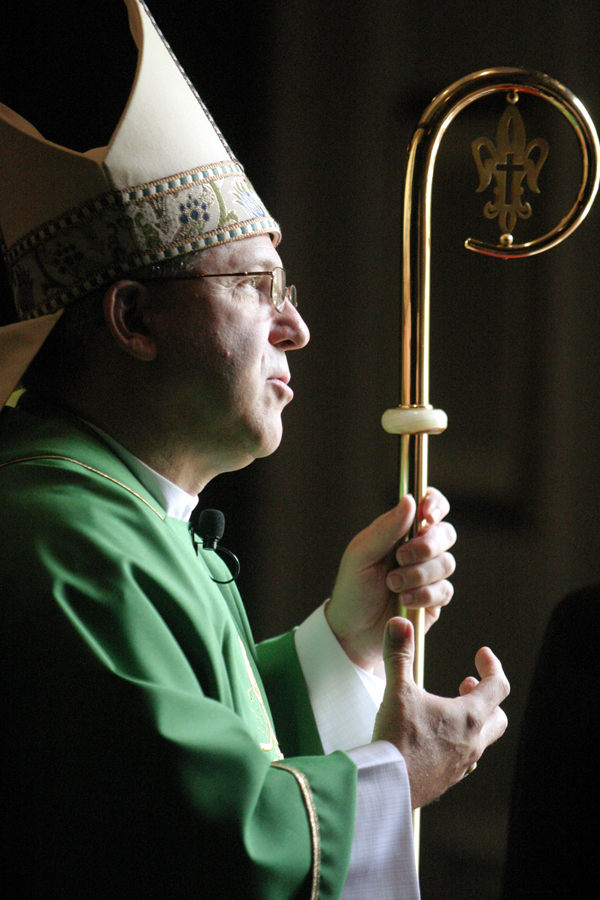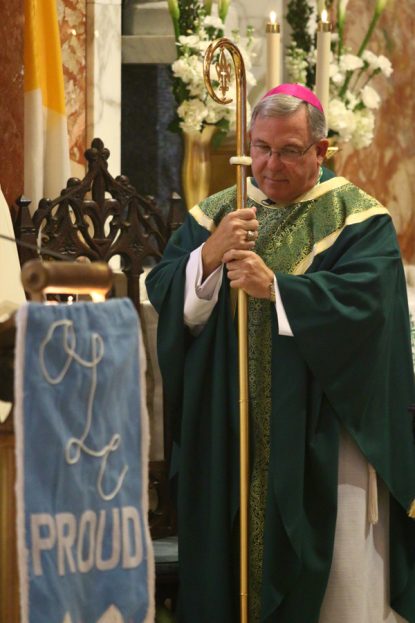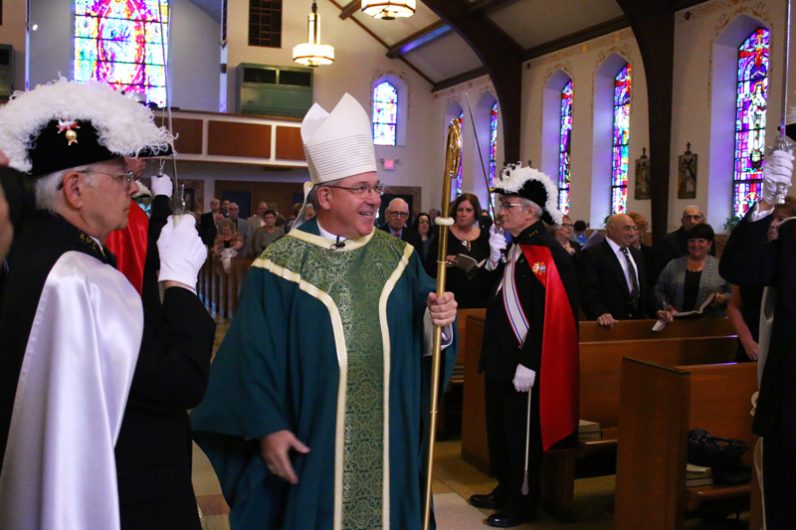
Bishop Joseph R. Cistone will be laid to rest in a funeral Mass Oct. 23 in Saginaw, Michigan. (Photo by Sarah Webb)
Bishop Joseph R. Cistone of the Diocese of Saginaw, Michigan died suddenly at age 69 in his home in the early hours of Oct. 16. Although he had lung cancer, his death was not immediately expected.
His funeral Mass will be celebrated at 11 a.m. Tuesday, Oct. 23 at the Cathedral of Mary of the Assumption in Saginaw, with Archbishop Allen H. Vigneron of Detroit as the celebrant. Video of the Mass will be livestreamed on the website of the Saginaw Diocese, Saginaw.org, beginning at 10:45 a.m.
(Watch the video feed below.)
Burial will follow at Mount Olivet Cemetery in Saginaw among the priests of the diocese.
A memorial Mass will be celebrated at 4:30 p.m. Wednesday, Nov. 7 in the St. Martin’s Chapel at St. Charles Borromeo Seminary. Archbishop Chaput will be the main celebrant and homilist, and all are invited.
Although he was bishop of Saginaw for the past nine years, Bishop Cistone was a Philadelphian for the first 60 years of his life. He was ordained a priest and an auxiliary bishop for the Archdiocese of Philadelphia, so it is natural that Bishop Michael Burbidge, also a former priest and auxiliary bishop of Philadelphia and now bishop of Arlington, will deliver the homily at the funeral. Bishop Burbidge was a co-consecrator when his friend became a bishop some 14 years ago.
In a comment for CatholicPhilly.com, Bishop Burbidge wrote: “I had the privilege of serving with Bishop Cistone at St. Charles Borromeo Seminary and at the Archdiocesan Central Administration Offices, and we have maintained a friendship throughout the years. He loved the priesthood and deeply appreciated priestly fraternity.
[hotblock]
“In all of his assignments and pastoral duties, Bishop Cistone’s profound love for the Lord and his church was evident, as was his zeal, enthusiasm and dedication. He enjoyed any opportunity to be with the faithful and could easily engage people of all ages. He was devoted to his dear parents and was a loving son and devoted family member. He also was proud to have served as a priest and bishop in the Archdiocese of Philadelphia.
“Upon being assigned as the bishop of Saginaw, Bishop Cistone pledged to serve the clergy, religious and faithful with the heart of a shepherd and his new diocese became his home. He was deeply grateful for the support and assistance he received in his ministry and for the prayers that accompanied him, especially during his time of illness.
“Bishop Cistone taught all of us how to carry the cross with deep faith and trust in God with a longing for the eternal reward we all seek. May God grant eternal peace to Bishop Cistone.”

Bishop Joseph Cistone returned to his native parish, Our Lady of Consolation in Philadelphia’s Tacony section, in October 2017 to celebrate the parish’s 100th anniversary. (Sarah Webb)
Joseph Robert Cistone was born May 18, 1949, the second of the three sons of Daniel and Josephine (Altomare) Cistone, preceded by his brother Daniel Jr. and followed by his brother Anthony. The family were members of Our Lady of Consolation Parish, which was then a tight-knit Italian personal parish in the Tacony section of Philadelphia. Because many of the parishioners married parishioners, most were related in one way or another.
Active in the parish, his parents were coordinators of the annual parish carnival and his father was president of the Holy Name Society.
Joseph attended Our Lady of Consolation School, where he was taught by the Sisters of St. Francis of Philadelphia, and then he went on to Father Judge High School with the Oblates of St. Francis de Sales. Immediately after his 1967 graduation he enrolled at St. Charles Borromeo Seminary.
It really was not a surprise to his family because from an early age he exhibited great devotion and was especially influenced by Father James V. Rosica, the dynamic and well-loved pastor at his parish. Father Rosica was so much a part of his decision to enter the priesthood that Bishop Cistone, years later, would use the older priest’s chalice for his first Mass in Saginaw.
Barbara Thaite, the parish secretary of Our Lady of Consolation, like so many others, is a life-long parishioner and was a contemporary of the future bishop although they were not in the same grade.
“Ours was a ‘Little House on the Prairie’ school,” she said. “Everybody knew everybody. I knew who he was, and he always looked like he was going to be somebody and so I wasn’t surprised when I heard he was going into the seminary. But he never forgot the parish. When we had our hundredth anniversary (October 2017) he came back for it and he really enjoyed it, he was in great spirits.”
Because of the distance, parishioners regret that many of his friends and contemporaries can’t travel to Michigan for his funeral but there will definitely be a Memorial Mass for Bishop Cistone at Our Lady of Consolation shortly, Thaite said.
Dan Cistone, his older brother by two years, remembers his brother as “a good kid, we got along well,” he said. “Joe always wanted to be a priest and even when he was 6 years old, he would play at celebrating Mass.”
He also remembers his brother doing all the typical things boys do, such as playing ball and being a member of Boy Scout Troop 419 at neighboring St. Leo Parish.
[tower]
Father Angelo Citino, a second cousin and contemporary of Bishop Cistone, also was raised in Tacony and went to Our Lady of Consolation School, and he too was a member of the Boy Scouts at St. Leo.
“Joe’s aunt was our den mother,” he said. “Joe was a very faithful son to his parents, dedicated to them and totally dedicated to the church. We grew up around the corner from each other and were altar boys together. Our Lady of Consolation was a very tight-knit parish.
“I knew he was sick but I shocked by his death,” Father Citino said.
Joseph Cistone became Father Joseph Cistone on May 17, 1975 when was he was ordained to the priesthood by Cardinal John Krol at the Cathedral Basilica of SS. Peter and Paul. He was just one day shy of his 26th birthday. His first Mass was celebrated the following morning at Our Lady of Consolation Church.
For the next 16 years Father Cistone served in a series of parishes as parochial vicar, with each assignment a unique experience. First there was Epiphany of Our Lord in South Philadelphia (1975-1979) where through a novena he developed a deep devotion to the newly canonized St. John Neumann, to the point that years later as bishop his coat of arms would reflect those of Philadelphia’s first saint.
Epiphany was followed by St. Jerome in Northeast Philadelphia (1979-1982) where he was most affected by the example of faith of a young boy who died after a long illness and whose rosary he kept as a treasured memento.
Next, at St. Jude in Chalfont (1982-1997) his ministry got off to an interesting start.
He was there barely a month when the pastor, the late Father John Bartos, left on a pilgrimage to Rome, leaving the young priest in charge. It may be apocryphal that Father Barton jokingly told him before leaving, “Don’t burn the church down while I’m gone.”
In a sense that’s what happened but it wasn’t Father Cistone’s fault. There was a novena to St. Jude in process and with so many votive candles alight, one night the church caught fire and did burn down. If this was a literal baptism of fire, Father Cistone learned a lesson in the value of the laity. The parish leadership immediately responded and very quickly arrangements were made for the celebration of Mass in temporary quarters.
“The laity are there to assist you,” Bishop Cistone later said.
Upon his return Msgr. Bartos too was an example of quiet efficiency as he quickly rebuilt his church.
Further parochial experience came through assignments as assistant at St. Francis, Norristown (1987-1989) and St. Bernard, Philadelphia (1989-1991) where he was just blocks away from his childhood church, Our Lady of Consolation.
In 1991 Father Cistone received his first administrative assignment, as opposed to parochial assignments, when he was named dean of formation for the theology division at St. Charles Borromeo Seminary.
The position did not involve theological teaching. A good part of his work was training the advanced seminarians on what they should expect after ordination in parish ministry, probably as parochial vicars, based on his own experience as a parochial vicar in five assignments.
After just two years at St. Charles Seminary, in 1993 Cardinal Anthony Bevilacqua called him to the central administration of the archdiocese, first as associate to the vicar for administration, then assistant to the vicar for administration, and finally in 1998 as vicar for administration and vicar general, succeeding Bishop Edward Cullen who was named Bishop of Allentown.
[hotblock2]
In that same year Pope John Paul II raised Father Cistone to the rank of monsignor. The administrative organizational chart printed in the Philadelphia Archdiocesan Directory of that time shows every administrative office in the archdiocese ultimately reported to the vicar for administration, not the archbishop of Philadelphia; Msgr. Cistone alone reported directly to the archbishop, Cardinal Anthony Bevilacqua.
The auxiliary bishops, while nominally also vicars general, were shown on the chart only as advisers to the archbishop. To be vicar of administration was an enormous responsibility. The buck stopped with the archbishop but the vicar for administration wasn’t far behind.
The 1990s were turbulent times in the archdiocese, with parish closings caused by lower Mass attendance and Catholics moving for older city parishes to growing suburban parishes, and Msgr. Cistone was heavily involved in the process.
Many good things also happened in those years, for example the canonization of St. Katharine Drexel in 2000.
But also at that time an awareness of the clergy abuse of minors began to emerge, a problem that had been quietly festering for many years. While the issue arrived at the desk of the archbishop, it also came up the chain of command, including the desk of the vicar for administration.
Reflecting on this later, before he left Philadelphia, Bishop Cistone said, “In so many ways, I continue to try to comprehend the depth of the tragic abuse of children, especially by priests, and to appreciate the pain and suffering such abuse has caused victims as well as the church at large.
“Looking back, I can appreciate how the Lord was moving me to better understand in my head and my heart the devastation caused by sexual abuse and to be more proactive in assisting victims and educating adults.”
In 2004 Msgr. Cistone was appointed auxiliary bishop of Philadelphia by Pope John Paul II and given the titular see of Casae Medianae, a former diocese in ancient Numidia. As is customary, a heraldic shield was created for Bishop Cistone utilizing symbolic elements of importance to him with references to St. John Neumann, the Blessed Mother and St. Joseph.
His episcopal consecration took place at the Cathedral Basilica of SS. Peter and Paul on July 8, 2004 with Cardinal Justin Rigali as consecrator and Bishops Robert Maginnis and Michael Burbidge as co-consecraters.
“Every time a bishop is consecrated it is a sign of God’s providential care for his church,” Bishop Cistone said in a statement after his ordination. “God loves you and is concerned for your well-being and salvation. So he is sending me to you as a shepherd, to guide you in the ways of the Lord and to lead you in a life of holiness, most especially by my own example. It is an awesome responsibility and I promise to do my best to be that shepherd for you, always relying on the Father’s mercy and love.”
In fact, that was his motto: “Father of Mercy and Love.”
Shortly afterward Cardinal Rigali reorganized the administrative offices of the archdiocese to divide the duties among all four of his auxiliary bishops. Bishop Cistone retained oversight of several of the secretariats and offices, plus regional bishop for the southern part of Philadelphia and parts of Delaware County, as well oversight of the recently formed Office for Child and Youth Protection.
On May 4, 2009 he received a telephone call from the papal nuncio, Archbishop Pietro Sambi, informing him the Pope Benedict XVI had appointed him Bishop of the Diocese of Saginaw, succeeding Archbishop Robert Carlson who became Archbishop of St. Louis.
“I hope that in some way my ministry in Saginaw will bring credit to Philadelphia,” he said in his farewell.
His new diocese was quite different than Philadelphia in several respects. Territorially it was more than three times as large, but with a Catholic population of about 100,000 or about 8 percent of that of Philadelphia.
It was also losing population because of the decline in the automobile industry in Michigan and the consolidation of farms, as Father Bill Rutkowki, Saginaw’s vicar general, explained. On land that might have had seven farms and farm families, now there might be a single highly mechanized farm.
When Bishop Cistone arrived, “he brought a joyful spirit; meeting and greeting,” Father Rutkowski said. “He had a big heart, not just for the people but for the priests. He was a stabilizing force. He united the priests of the diocese and also promoted priestly vocations. Next year we will possibly ordain three priests, all of them recruited by him. From his experience at St. Charles Seminary he knew what to expect from a candidate and what to look for in a candidate.”
After his arrival in Saginaw Bishop Cistone quickly realized there were far too many parishes relative to the size of the Catholic population and the number of available priests.
He did not act immediately but gathered facts. In 2011 he issued a pastoral letter, “A Future Full of Hope,” explaining the problem and possible solutions.
The end result was a program very similar to the current Parish Pastoral Planning in Philadelphia, inviting both the priests and lay people to come up with consolidation plans everyone could live with — except the Philadelphia process is ongoing and Saginaw’s is completed.
The various committees of priests and laity made recommendations with final approval by the bishop. In the end, the 106 parishes of the diocese were pared down to a manageable 67.
“The whole process was completed by 2015,” Father Rutkowski said. “He was a pastor dealing with his people and a pastor dealing with his priests. He had a blend of skill for doing things and making the tough decisions that had to be made, but he had a pastoral heart. When you have a heart and love the people, it makes a difference.”
There was also a side to Bishop Cistone that perhaps was not seen in more uptight Philadelphia. On YouTube one can find video clips of him singing comedic songs as he played his guitar at the annual fundraiser, the Bishop’s Ball. That was a skill he picked up at St. Charles Seminary.
Last year, perhaps sensing the throat cancer that finally killed him was getting worse, the guitar was one of the auction items at the ball.
He served on a number of committees with the United States Conference of Catholic Bishops, made mission trips to poor countries and continued his tradition of attending the annual March for Life in Washington each January, which from a logistics point is a lot harder from Saginaw than it was Philadelphia.
Among his proudest achievements was the thorough renovation of the Cathedral of Mary of the Assumption, which by the way now has a Philly touch through images of St. John Neumann and St. Katharine Drexel.
Yes there were times of sorrow too. The clergy scandal that first came to light in Boston and Philadelphia spread like another form of cancer throughout the country, including little Saginaw.
“There is no way it didn’t affect him,” Father Rutkowski said.

Bishop Joseph Cistone greets old friends at Our Lady of Consolation Parish in October 2017. (Photo by Sarah Webb)
PREVIOUS: Eagles can teach us how to engage at Mass, says La Salle professor
NEXT: Priest friends, 1975 classmates, recall life of Bishop Cistone



Shredded memo of 1994 with the list of abusive priest seems to be left out of this article. Also, wasn’t the chancery in Saginaw raided by law enforcement a few months ago?